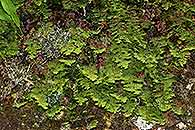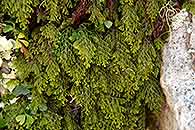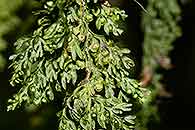Hymenophyllum kuhnii C. Chr.
Synonyms |
Hymenophyllum polyanthos (Sw.) Sw. var. kuhnii (C. Chr.) Schelpe |
|---|---|
Common name |
|
Description |
Rhizome wiry and thin, widely creeping, hairless or sometimes set with persistent ventrally attached hairs to 1 mm. Fronds spaced 0.5-5 cm apart. Stipe up to 10 cm long, without hairs, narrowly winged in the upper part. Lamina usually oblong to narrowly elliptic in outline, 3-60 × 1.5-7 cm, 2- or 3-pinnatifid, finely dissected into up to 100-180 lobes per pinnae, hairless. Pinnae to 8 x 1.5 cm, ultimate lobes 3-5 on each side, to 6 x 2.5 mm, set close together or overlapping, linear in outline, apices rounded, margin entire. Rhachis winged. Sori along the costae of the pinnae on the innermost lobes, several per pinna, broadly obconic to rounded in shape, 1.2-1.8 mm long and wide; soral valves entire. |
Notes | Can be separated from other species by having hairless fronds and entire lobe margins. Can be distinguished from H. capense by having pinnae that are composed of more than 15 lobes. Can be separated from H. mossambicense by having a rhizome that has persistent ventrally attached hairs and ultimate lobes that are set close together or overlapping. |
Derivation | kuhnii: named after Maximillian Kuhn a German physician and botanist. |
Habitat | Shaded, moist, high-altitude evergreen forest, ridge-top forest, occasionally in giant heath forest. |
Distribution worldwide | Africa, Madagascar. |
Distribution in Africa |
Angola, Cameroon, Dem. Republic of Congo, Equatorial Guinea (incl. Bioko), Gabon, Guinea, Kenya, Liberia, Malawi, Mozambique, Nigeria, Rwanda, Sierra Leone, South Africa, Tanzania , Uganda, Zambia, Zimbabwe. |
Growth form |
Epiphytic, lithophytic. |
Literature |
|







